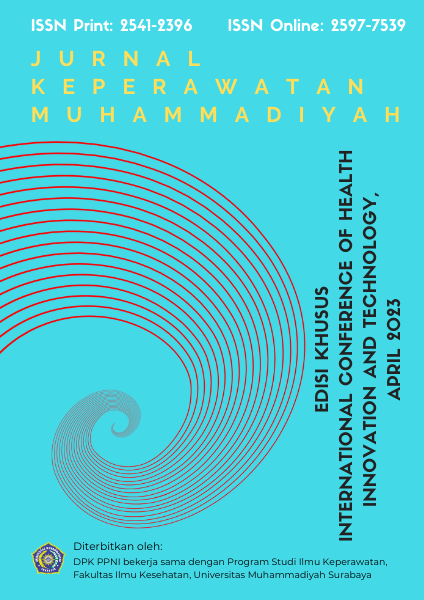ANALISIS FAKTOR RISIKO STUNTING PADA ANAK BALITA DI DESA WAGIR KIDUL, PULUNG, PONOROGO
DOI:
https://doi.org/10.30651/jkm.v0i0.17871Keywords:
Stunting, Risk Factors, ToddlerAbstract
Objective: Stunting is a condition where a child's height is shorter than the height of other children his age. Stunting can interfere with brain development, intelligence, physical growth disorders, and metabolic disorders in the body and even cause other dangerous diseases such as cancer and stroke.
Methods:Â Â The purpose of this study was to determine the dominant factor influencing the incidence of stunting in the working area of the UPT Puskesmas Pulung, Ponorogo Methods: This study is an observational study with a cross-sectional study design and quantitative analysis. This study has a sample of 32 people. The instrument used in this study was a questionnaire. Data analysis using Logistic Linear Regression.
Results: The results showed that history of infectious diseases, environmental sanitation, economic factors, mother's knowledge, and parenting patterns significantly affected the stunting status of toddlers with a p-value less than (0.05).
Conclusion:Â Based on the results of this study, it is expected that health workers will provide health education related to stunting, prevention methods through fulfilling nutrition, good sanitation, and preventing infection in childrenReferences
Jurnal Ners dan Kebidanan. 3 (2), 268-278
Noftalina,Elsa.,Mayetti.,&Afriwadi. (2019).Hubungan Kadar Zinc danPolaAsuhIbudenganKejadian StuntingpadaAnakUsia 2 – 5 Tahun di KecamatanPantiKabupatenPasaman. JurnalIlmiahUniversitas Batanghari Jambi. 19 (3), 565-569
Oktaviana, W., Keliat, B. A., Wardani, I. Y., & Pratiwi, A. (2022). Effectiveness of health education and infant therapeutic group therapy on baby aged 0-6 months to prevent stunting risk factors: Maternal depression. Journal of Public Health Research, 11(2).
Pedro, A., Batweni, Z., Bradfield, L., Dare, M., Nyman, A., Petersen, C. A. L., & Truskey, K. M. (2022). First 1000 days: first-time mothers’ understanding and experiences of nutritional care. Early Child Development and Care, 192(10), 1561-1569.
Rahmadani, Hilma. (2019). Hubungan Tinggi Badan Ibu dan Status Ekonomi Keluarga dengan Kejadian Stunting Pada Anak Usia 24-59 Bulan di Wilayah Kerja Puskesmas Ikur Koto Padang. FakultasKedokteranUniversitasAndalas. Skripsi
Sari, Corry O., DyahNoviawati., & Tri Maryani. (2019). Hubungan Pola Asuh Ibu Dengan Kejadian Stunting Pada Balita Usia 25-59 Bulan Di Wilayah Kerja Puskesmas Sentolo I Kabupaten Kulonprogo Yogyakarta Tahun 2018. Fakultas Keperawatan Politeknik Kesehatan Kementerian Kesehatan Yogyakarta. Skripsi
Wulandari.,Fitri R &Darmawansyah. (2019). Hubungan Sanitasi Lingkungan Dan Riwayat Penyakit Infeksi Dengan Kejadian Stunting Di Wilayah Kerja Puskesmas Kerkap Kabupaten Bengkulu Utara Tahun 2019. Jurnal Ilmiah Alvicenna. 9 (8), 9-20
Yan, B., Vember, H., & Loots, R. (2021). Effectiveness of Intervention Practices in Preventing Childhood Malnutrition in a Semi-rural Area of the Western Cape. Child Care in Practice, 1-18.
Downloads
Published
Issue
Section
License
- Penulis tetap memegang hak atas karyanya dan memberikan hak publikasi pertama kepada jurnal ini yang secara simultan karya tersebut dilisensikan di bawah:Â Creative Commons Attribution-ShareAlike 4.0 International (CC BY-SA 4.0)













